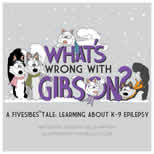The Fears of Epilepsy
By Roy Dvorak
We continuously wonder
if the next seizure will be tonight. We sleep with a towel at
the head of the bed to catch her anals or urine if she does have
a seizure. We schedule events around 7 AM, 3 PM and 11 PM since
these are the times that Korie gets her 60 mg of phenobarbital
to help control her seizures. We celebrate every month that passes
without a seizure. We also live in fear that the epilepsy monster,
like the monster in Aliens, will rise up again, grab us by the
throat, look us in the eye while its saliva drips from the razor
sharp teeth and tell us that he is still here.
As the seizure subsides, the monster fades away, but he reminds us that he will return. We fear that the next seizure could be her last seizure. We fear that the seizure will give her temporary blindness and disorient her and cause her to pace the room and continuously bump into walls and furniture and not know her name. We fear that the recovery to her normal mischievous self may take several days. We fear . . .
There are two types of fears: rational and irrational. The fears that have grown out of epilepsy are very rational and they must be harnessed. We must put them in their place, someplace away from our daily emotions. To control these fears and to live with these fears, we continue to educate ourselves by reading neurological veterinary books, articles on canine epilepsy, subscribing to the EPIL-K9 web site, and talking to people in the same situation as we are about our fears. With learning comes understanding and with understanding comes the ability to live with and control and possibly overcome our fears. If we do not deal with these fears, then we are of no use to Korie. We cannot let the fear of epilepsy control our lives, we must learn to live with it. The first thing for us to do regarding Korie's seizures was to accept the fact that she has primary inherited epilepsy and she will not be the beautiful winning show dog we hoped for. The second thing was to accept the fact that there is no cure for epilepsy and she will have it for the rest of her life.
I briefly mentioned what we fear, and it is not the unknown as some would say. There is really nothing unknown about epilepsy except what combination of genes that causes it. All of the medical books pretty much describe what epilepsy is or rather what causes a seizure. The problem, if one wishes to use such a word, is that we are totally helpless to assist Korie when she is in the throes of a seizure. We have learned to live with our fears, but we do not fear epilepsy, we despise it for what it does to our loved one. We know what the epilepsy monster does, but we never know when the beast will return.
In addition to our fears, we and others always play the "what if" game. What if we are on the way to a dog show or on vacation and Korie has a seizure? What if we go out for dinner and she has a seizure and we are not there to comfort her when she is given back to us by the epilepsy beast? What if emergency help is not available? What if she goes into status? What if we cannot give Korie the quality of life that we want her to have? And there is one question we ask: "Why us?" and we rephrase it to: "Why Korie?"
Epilepsy has no cure, but it can be managed. Through the educationational process we try to learn everything we possibily can so we may manage Korie's epilepsy. Through a management process of medication, diet, vitamin and mineral suppliments, we can control the seizure activity and keep the beast contained. We know that there are other people in the same situation as us who we can share our success in seizure control or failure. They know what we go through when Korie has a seizure and we know what they endure when their loved one has a seizure. The support we give each other gives us the strength to fight the hideous beast. With the education and support, we can make it through another day. As Michelle from the EPIL-K9 list wrote "...we learn how to wake up each morning with appreciation of having passed another good night and learning how to come home each day not with a sense of dread but with a hopefulness that all was well and being grateful and releived when it was. Yes you have to worry and dread, but the key is to keep focusing on the daily milestones of releif!"
Page last update: 05/30/2011










